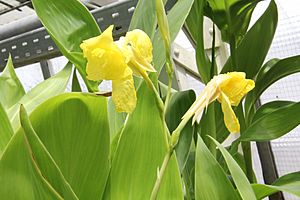Bandana-of-the-everglades facts for kids
Quick facts for kids Bandana-of-the-everglades |
|
|---|---|
 |
|
| Canna flaccida, only yellow, lightly perfumed canna. | |
| Scientific classification | |
| Genus: |
Canna
|
| Species: |
flaccida
|
| Synonyms | |
|
|
The Canna flaccida is a beautiful plant that belongs to the Canna family. This special plant naturally grows in wet areas like swamps and marshes. You can find it in the southern United States, from Texas all the way to South Carolina.
It has also spread to other parts of the world. You might see it growing wild in places like India, the Philippines, Mexico, and parts of South America.
This plant is important because it helped create many new types of cannas. These new cannas were once called "orchid flowered cannas." Now, they are known as Italian Group cannas. The Canna flaccida is also known as a water canna because it loves to grow near water.
An early American explorer named William Bartram first described this plant. He found it blooming near rivers in coastal Georgia. Its seeds can float down rivers and easily start new plants on the shorelines. This plant was brought to England in 1788.
The Canna flaccida is a perennial plant. This means it lives for more than two years, often coming back each spring. It can grow up to 1.5 meters (about 5 feet) tall. It prefers warm climates and is sensitive to frost. In northern areas, its flowers bloom from August to October. The seeds are ready in October. Its flowers have both male and female parts.
How Scientists Name Plants
Scientists use a system called taxonomy to name and group living things. This helps everyone understand which plants are related. For the Canna plant family, two main scientists, Paulus Johannes Maria Maas from the Netherlands and Nobuyuki Tanaka from Japan, have studied them a lot.
Both scientists agree that Canna flaccida is its own unique type of plant. DNA studies done by Prince and Kress at the Smithsonian Institution also confirm this. This means it's a distinct species, not just a variation of another Canna.
What Does It Look Like?
The Canna flaccida is a water-loving plant. It has long, narrow leaves that are a pretty blue-green color. Its flowers are a bright canary yellow and have a light, pleasant smell. These large flowers grow in bunches at the top of tall stalks.
One cool thing about its flowers is their wavy lip. Even more interesting, these flowers open in the evening! They then close and wilt in the heat of the next day. This is very unusual because most other Canna flowers open in the morning and stay strong for at least a full day. You can often find this plant growing along the edges of still or slow-moving water, in water up to about 15 centimeters (6 inches) deep.

